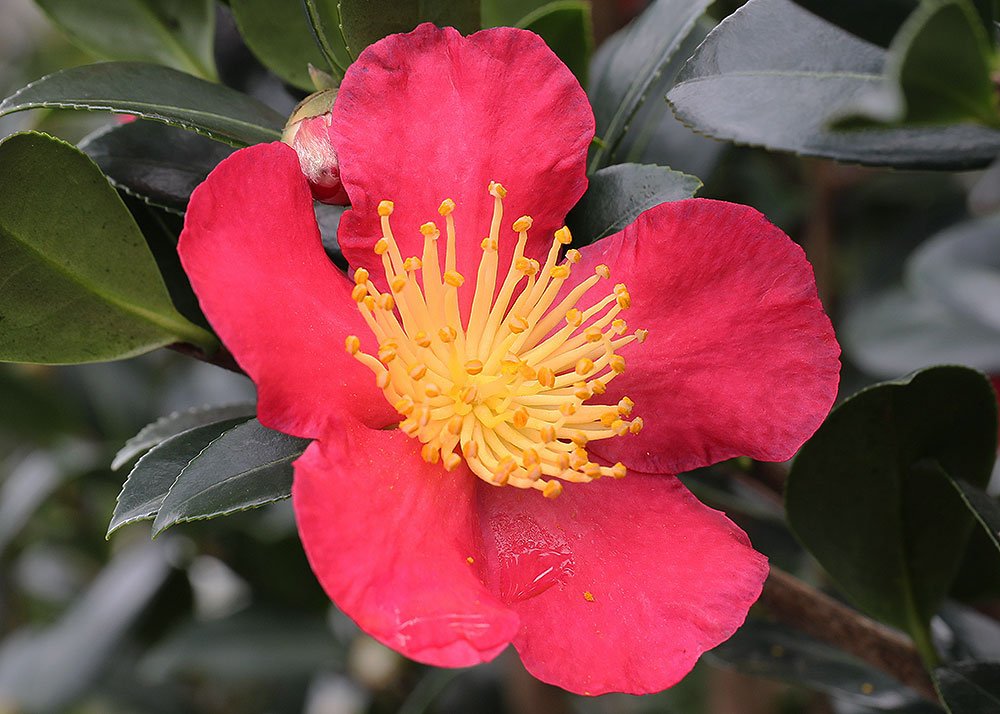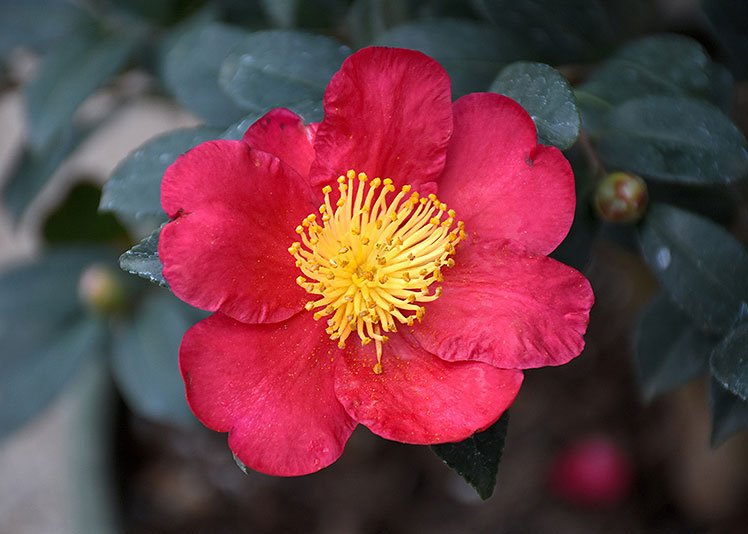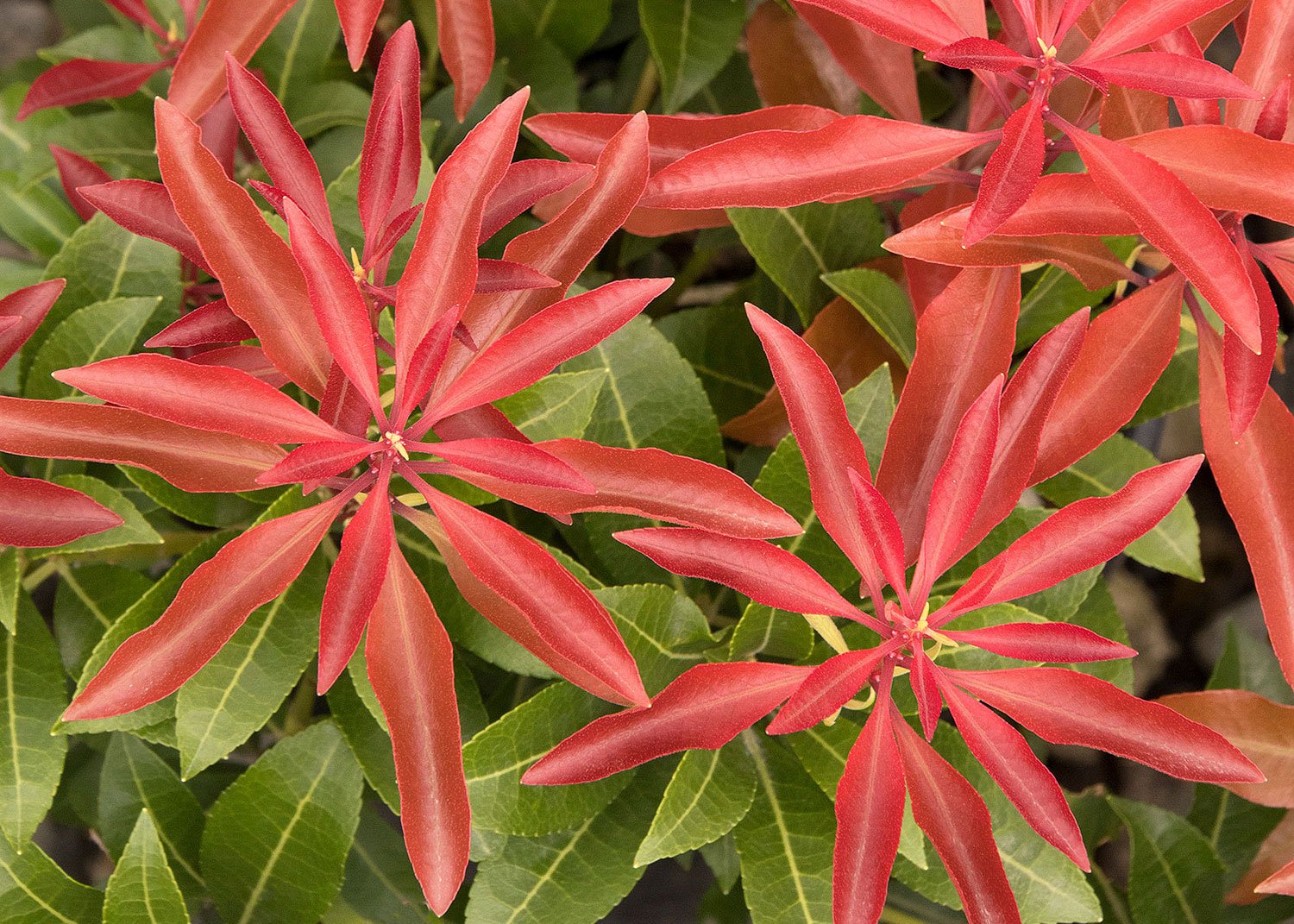Often, one of my first orders of business when designing a garden is to embellish the immediate surroundings of the house. Carefully selecting plants to enhance the view just outside of our windows can go a long way toward staving off the winter blues, and if those plants offer a bit of fragrance as we scurry back and forth while gathering provisions, so much the better. Strong form or foliage is essential, and winter flowers, bark, or berries also offer off-season interest. Plants that attract birds bring motion and a second layer of color. Here are a few options to brighten the dreary Northwest wintertide.
Camellia sasanqua
Camellia sasanqua is the undeservedly less popular sibling of the more commonly planted Camellia japonica. Unfair I say, as C. sasanqua is a better plant in my over-educated opinion. With an average mature height of 15 feet, C. sasanqua is a bit less robust than its larger sibling, so it’s suitably sized for today’s smaller gardens, and eminently more malleable to pruning shears. It can even be shaped into a hedge, and it makes a lovely espalier, either as a screen or on a wall. (As with most flowering shrubs, it’s best to prune immediately following flowering to avoid cutting off next year’s buds).
Camellia sasanqua ‘Yuletide’
The primary selling point for C. sasanqua over C. japonica is the former’s fastidious attribute of politely jettisoning its spent flower heads following bloom. This is in sharp contrast to C. japonica’s trait of clutching its browning blossoms long after they’ve finished blooming, and indeed much longer than they are welcome, as the fading flower heads eventually turn into what appear to be grimy lumps of soiled tissue whose origins are best left unconsidered.
Hardy to USDA Zone 7, in most years blossoming will begin in mid-autumn and continue through December, depending on which cultivar you select. While the foliage is perfectly hardy in Greater Pugetopolis, the buds can occasionally be nipped by an early frost; a quick and temporary covering of frost cloth will usually protect the buds until more clement conditions return. Careful placement under a high tree canopy or adjacent to a sheltering wall will also usually preserve and extend the season of bloom. Even if the blossoms are occasionally lost, the delicate evergreen foliage and sculptural bark offer 4 seasons of interest.
Camellia sasanqua ‘Setsugekka’
Cultivars and hybrids number in the thousands, so there’s surely a choice for every garden. Mature heights vary from 3-foot high dwarf cultivars to 20-foot trees, and color choices range from white/cream to every possible shade of pink to the deep red of “Yuletide.” Multicolored flowers in the aforementioned shades are also available. As an added bonus, the flowers of many selections have a delicious fragrance of cinnamon and clove, mixed with a hint of musk, which carries on the wind on crisp autumn and winter days. Hummingbirds, bees, and other pollinators adore the blooms.
Tough and easy to please, about the only things that Camellia sasanqua detests are heavy clay or alkaline soil, which makes it a perfect candidate for our rain-drenched Western Washington gardens. It will take full sun here, but it’s also happy in a half-day of shade, although flowering will be slightly reduced. It will tolerate a surprising amount of drought when established, but flowers more prolifically with regular watering in late summer and fall when the buds are being set.
Camellia sasanqua ‘Shishi Gashira’
The details of the introduction of C. sasanqua to Western gardens are a bit murky. Although first described by Linnaeus protégé Carl Thunberg in Flora Japonica (published in 1784) following his visit to Japan in 1775-1778, actual plants appear to have begun arriving in England on ships from the Dutch East India Company in 1811 and 1812. Common names include Christmas Camellia, for its season of bloom, and Lady Banks Camellia, for its floral resemblance to the Lady Banks rose. Along with C. oleifera, it is a source of camellia oil, and the remaining residue from pressing the seed into oil has been used to poison undesirable predatory fish in lakes and streams. C. sasanqua is not toxic to mammals, although if your pet were to ingest an entire 15’ tall tree, you might want to keep an eye on them.
Mahonia ‘Arthur Menzies’
The background story of our next plant is well-documented. Mahonia ‘Arthur Menzies’ (not to be confused with Archibald Menzies, the namesake of our native Arbutus menziesii, AKA Pacific Madrone) is a result of a chance seedling arising in our very own Washington Park Arboretum. Arthur Menzies was the supervisor of plant accessions (and eventually Assistant Director) at the Strybring Arboretum in San Francisco, and in 1961 he sent several seedlings of Mahonia lomarifolia from his own garden north to the WPA. One of the seedlings was clearly different from the others, with foliage bearing a similarity to the much hardier M. bealei. The folks at WPA suspected they may have a chance hybrid seedling, and a hard December freeze a few years later confirmed their suspicions when all but the hybrid seedling were reduced to piles of gelatinous goo. The surviving plant emerged relatively unscathed and was named in honor of Menzies by WPA Director Brian Mulligan. Subsequent investigation has indeed confirmed the assumed lineage, and the plant has become a sought-after addition to collectors’ gardens. It has since been reclassified as belonging to the genus Berberis, but as it is vastly different in appearance from most barberries, normal folks (i.e., non-taxonomists) still refer to it as a Mahonia.
Hummingbird feeding on Mahonia ‘Arthur Menzies’
‘Arthur Menzies’ begins flowering around Christmas, about 6 weeks later than the more common Mahonia Charity, extending the season of bloom for these sturdy winter gems. It bears 12” tall flower clusters similar to other Japanese Mahonias, with honey-scented stacks of blossoms that withstand the worst that Puget Sound winters can throw at it. The flowers provide an important nectar source for our resident Anna’s hummingbirds, and the berries produced the following summer are greedily gobbled by a host of resident and migrating birds.
As with nearly all mahonias, the tropical-looking leaves are tipped with needle-sharp spines, so take care to wear eye protection, sturdy boots, and stout gloves when working near this plant. A set of Kevlar overalls or a suit of armor are also a good idea if you have either handy. While I don’t generally recommend plants that pack the puncture potential of this genus, this one is more than worth the risk.
Slow growing, the plant can reach 12' feet or more in both height and width, so be sure to give it some elbow room. Over the course of a decade or two, it eventually makes a nice small tree. It’s also eminently prune-able and can be kept to a size of 10’ x 10’ or less by trimming the sides and thinning the center a bit to expose the ridged, furrowed bark. It’s best to keep it pruned back a few feet from foot traffic, as the formidably-armed foliage has the potential to inflict harm on unsuspecting passersby. It also responds well to radical renovation and can be cut to about a foot off the ground if absolutely necessary. Be prepared for it to respond by throwing up a multitude of prickly shoots, charging forth from the established root system like an angry porcupine.
Mahonia ‘Arthur Menzies’
Plant it anywhere, from full sun to full shade. It will want a bit of water if planted in full sun, and it flowers best with at least half a day of sunshine. It’s adaptable to clay or sandy soils, but happiest in a good loam, as are we all. In addition to its exotic, tree fern-like appearance, the foliage flushes in tones of red and purple in spring and also can take on similar hues in cold weather.
Menzies himself lived a rather remarkable life, serving in World War II and surviving the infamous Bataan death march as a POW. He was forced into servitude in a coal mine for 3 years, and it is believed that PTSD from his wartime experiences may have led to his death by his own hand in 1973 at the age of 57. His untimely demise was a substantial loss to the horticulture community, as he was known worldwide for his expertise and was considered to be one of the foremost experts on the native plants of California, a “walking encyclopedia of flora and fauna”. There is a splendid native plant garden at Strybring named in his honor. Twice married, his first wife gave birth to twin daughters. His daughter Tessa was the mother of Gavin Newsom, the current governor of the “Golden State”.
Pieris species and hybrids
What, that old thing? Yes, that old thing. Pieris is common as dirt. You’ll see it planted just about everywhere, from home gardens to institutions to gas stations. And there are sound reasons for it being used so ubiquitously: it’s tidy, tough, and 4-seasons gorgeous. Although they don’t begin blooming until late winter or early spring, the pendant chains of unopened buds provide plenty of punch during winter, and their glossy green foliage remains cheerful year-round. It was originally called Andromeda japonica, although it is no longer classified with Andromeda, a much shorter plant. Another common name is Lily of the Valley shrub, as the flowers somewhat resemble those of Convallaria, but the resemblance ends there and they are not related.
Most of the Pieris available these days are selections or hybrids of one of three species: Pieris japonica and Pieris formosa are Asian imports, and Pieris floribunda is from the mountains of Tennessee and Virginia south to Georgia.
Pieris japonica
Pieris japonica was introduced to England by William Kerr in the early 19th century. Kerr was a Scottish gardener at Kew who was sent to the Far East in 1804. Considered to be the first modern Western plant hunter to collect in Asia, the Chinese did not allow Kerr to travel and thus did the majority of his botanizing in nurseries and gardens. From his post at the port of Guangzhou, he introduced 238 new species, including P. japonica, to the West before he purportedly succumbed to an opium habit, which ended his career in 1814 at the young age of 35. P. japonica’s hardiness falls in between the other 2 species, and it sports honey-scented flowers and coppery-brown spring foliage. Pieris yakushimensis, which is now considered to be a compact variant of P. japonica, has contributed genetics that have resulted in a number of compact new selections that top out at around 3 feet tall.
Pieris formosa was introduced in the late 18th century, and though usually hardy in our area, is the most tender of the three species. The leaves and flowers are generally larger than the other two species, and its spring foliage flushes in coppery bronze. The variety “forrestii”, named for Scottish plant hunter George Forrest, features vividly bright red spring foliage and is particularly floriferous.
Pieris floribunda is a smaller and much hardier plant, surviving Zone 5 winters. It was discovered by John Lyon, yet another Scot (doesn’t Scotland have any plants of its own?!?), in Virginia in 1807. Dense of habit and slow growing, it has been used to contribute added hardiness to new hybrids. It’s a bit less floriferous and the foliage has a comparatively dull matte (yet still attractive) sheen in contrast to the other two species glossy green.
With a reasonable amount of summer irrigation, most Pieris will grow happily in full sun, but a half a day of shade is preferred. Heavy clay or compacted soils are problematic, but amending with a few inches of compost will give you a reasonable chance at success. They take well to pruning, but given a bit of room they can remain untouched for decades, eventually turning into small trees. They are not fond of windy sites, so choose the shelter of an east wall if you live on the shore, in the foothills, or east of the Cascades.
Pieris leaves, flowers, and seed capsules are toxic to mammals. The three characters used to write its Japanese name (which is “Asebi”) mean “Horse Drunk Plant”, so plant it a safe distance from your corral. On the upside, deer don’t touch it, at least not more than once, so it’s an excellent option for folks looking for evergreen foliage in Bambi country. Its late winter/early spring flowers are much appreciated by early pollinators like mason bees.
Pieris will usually reach a height of about 7 feet with a similar width in about 10 years. Very old specimens can exceed twenty feet. By hybridizing the above-mentioned species and by possessing a keen eye for happy accidents, plant breeders and nurserymen have blessed us with a plethora of Pieris cultivars, varieties, and forms. Choosing from the scores of options is a matter of hardiness and personal preference, but here are a few of my favorites:
The Valley Series
Selected during the mid-1960’s from an extensive research trial at North Willamette Research and Extension Center, the Valley series are all excellent garden plants. ‘Valley Valentine’ has deep red buds that open to pink flowers. ‘Valley Rose’ sports flowers that are pink on top, fading to white at the tips. ‘Valley Fire’ offers white flowers followed by flaming red spring foliage.
Pieris japonica ‘Valley Valentine’
‘Mountain Fire’
A hybrid of all three of the above-mentioned species, Mountain Fire has shrieking red spring foliage and is perhaps the most sun tolerant of the bunch. This one is a bit more susceptible to root rot, so fast-draining soils and judicious watering are recommended.
Pieris japonica ‘Mountain Fire’
New growth on Pieris japonica ‘Mountain Fire’
‘Forest Flame’
Forest Flame is a self-sown seedling discovered at Cornwall’s Sunningdale Nurseries. It is most likely a hybrid of P. japonica and P. f. forrestii. The flowers bear a fragrance reminiscent of lavender, starting out pink in bud and turning to white when they open. The foliage flushes bright red and then turns to creamy pink before settling into green in the summer.
‘Little Heath’
Little Heath has bronzy pink spring foliage which changes to variegated white and green in summer. Compact and tidy, this selection makes a great container plant. I’ve kept mine in a pot for over 10 years. Should you find variegation unsettling, a version with plain green foliage is also available.
‘Katsura’
Katsura is a recent introduction, has deep red buds similar to ‘Valley Valentine’ followed by pale pink flowers and burgundy-hued spring foliage.
Pieris japonica ‘Katsura’
According to recent click-bait on Ye Olde Interwebs, Seattle is the gloomiest place in America. While our dreary winters are not for the faint of heart, true Nor’westerners have developed a variety of coping strategies to see us through these dark days. Caffeine, cocktails, and chocolate can go a long way towards fending off the winter blues. And thankfully, while our skies might be gloomy we are blessed to live in a climate so benign that we have a multitude of options for brightening our winter views during the time of year when “gardening” is most comfortably accomplished through a nice thick pane of glass. So put down that chocolate croissant purchased from your local artisan bakery and take a moment between sips of that Irish coffee to consider the world just outside your windows. And remember, it won’t be long until we’re all back outside in the spring garden, chasing the rabbits, cursing the slugs, and fighting a losing battle against bindweed.
Editor’s Note: Varieties mentioned above may not all be available at all times. We would be happy to suggest similar alternatives to fit your individual space and needs!
Updated for 2023













